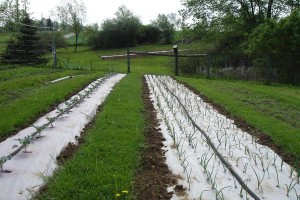SALEM, Ohio — Community Supported Agriculture, or CSAs, have grown in Ohio in the past 10 years. But the concept may be reaching critical mass, according to Brad Bergefurd, OSU Extension state horticulture specialist.
He should know. Bergefurd, who also conducts research at the OSU South Centers in Piketon, Ohio, is himself a CSA operator.
What’s a CSA?
In a CSA program, a farmer offers a certain number of “shares” of mainly produce — but sometimes eggs, meat and specialty products — to the public. Customers purchase a share, essentially a membership or a subscription, to receive seasonal produce each week throughout the growing season.
“What it needs is a lot of consumer education,” Bergefurd said. “For some customers, it is tough to show up every Saturday at the share at that specified time, and many have gotten out of CSAs for that reason.”
Having customers pay up front can be good business for farmers and a guarantee of produce and other commodities for customers, he added, and it is another marketing tool for produce operations. “But it doesn’t fit all customers.”
Growing business

Joli and Hank Fichter have operated a CSA at their farm near Minerva, Ohio, for the past seven years, providing a variety of vegetables, herbs and flowers.
“For our needs, we wanted to sell directly to our clientele,” Joli Fichter said. “The whole system of CSAs applied; like-minded people to be involved with. And neither one of us wanted a large staff.”
The CSA at Fichter Farm has grown to 40 families, Fichter said.
“We want people to know how we grow and the value we have,” she said. “That benefits local commerce, has an environmental impact, and it is very important to us to explain them importance of nutrients in food.”
Ohio CSA history
CSAs were designed, Bergefurd said, to put a face on the farmer.
“I think CSAs have done well in Ohio,” he said. “Produce farms have done a lot with CSAs, including multi-season events, and events where customers are invited to come to the farm and see their tomatoes on stakes, or high tunnels with produce growing.”
While Bergefurd does anticipate a leveling off of the number of CSAs across the state in coming years, he said he “doesn’t see any negatives” in the concept.
“For the customers, you are guaranteed a certain amount of produce each week and you are the first to get it,” he said. “For example, the blackberry crop was damaged this year, but CSA customers were among the first to get blackberries. For farmers, you are prepared in advance; it can be a monthly cash flow to pay for seed and plants and things.”
Ohio CSA numbers have leveled in the past five years, Bergefurd said, a trend similar to what happened on the East Coast, where CSAs had their beginnings in the mid-1980s.
Multiple farms
The first formal study of CSAs in Ohio was conducted in 2009, according to Stan Ernst, an agricultural and consumer economist at Ohio State University specializing in food trends and niche marketing opportunities. The 2009 study identified approximately 132 CSAs, Ernst said, adding statewide numbers are up to around up to 150 now. What’s also changed since 2009 is the model, a change in the types of CSAs and missions you see, he said. Aggregation, with more farms coming together to form a single CSA that can offer more variety, is a growing trend, Ernst said.
“One of the reasons you see that kind of aggregation is that producers want to provide a CSA year-round,” he said. “And those who are taking it to the next level are sometimes offering more crafty things like soaps.”
Trends and predictions
Another growing trend, Ernst said, is “a throwback to the good old days” of a community-supported farm instead of community supported agriculture.
“Maybe you have a church organization growing food, which is not necessarily a farm, but is a low-cost option for those in the community,” he said. “And they may not pay all up front, but rather a monthly fee. So there may be a change in the fee structure, but it’s still a subscription service.”
Bergefurd, however, is concerned with some industry changes. He said some CSAs are purchasing produce while using the CSA subscription model.
“If some customers want that, as long as they know that it is happening, I suppose it is all right,” he said. “I just think it fractures the model.”
Ernst said the future of CSAs depends on much broader concepts than a program itself.
“CSA operators tend to be younger than traditional farmers — not many are five generations of a family. So the churn will be there,” he explained. “The other thing is that you can put a lot of hard work in to not make a lot of money. It’s not something you do to make a full-time living.”
How much traction the overall local food movement maintains is, in Ernst’s opinion, the key to predicting what the future holds for CSAs.
“It is a legitimate trend and something producers at all levels have to pay attention to and participate in,” Ernst said.
Still, he said, he is skeptical of how much growth potential exists.
“The problem some operators run into is that a CSA looks cool, but what are (customers) going to do with all that food?” Ernst said.

Fichter said she ran into this problem early on, but she feels the momentum of the local food movement — and interest in CSAs — will continue.
“The old adage ‘you are what you eat’ is everywhere now,” she said, “from National Geographic and the New Yorker, to doctor columns in daily papers. There is definitely an increase in interest and I think it’s really going to grow.”
Learn about your local farmers by getting
Around the Table.
It's a FREE weekly e-newsletter all about food. Sign Up Today!















